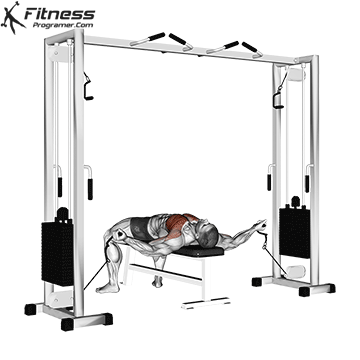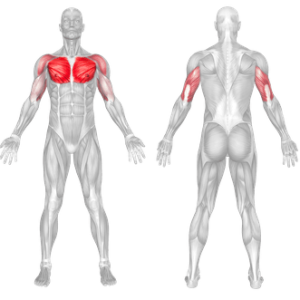Lying Cable Fly Overview
The Lying Cable Fly is an isolation exercise that primarily targets the chest muscles, specifically the inner and lower portions of the pectoralis major muscle. By providing constant tension throughout the movement, it allows for a greater range of motion and superior muscle engagement compared to traditional free-weight flyes. The Lying Cable Fly is an excellent complementary exercise to compound movements like the bench press.
How to Perform the Lying Cable Fly

Setup
- Position the Bench: Place a flat bench in the center of a cable crossover machine or near two adjustable pulley systems.
- Adjust the Pulleys: Set the cable pulleys slightly below or at the same height as your shoulders when lying down.
- Attach Handles: Attach single-grip handles to each pulley.
- Grip the Handles: Lie on the bench and hold the handles with your palms facing inward (neutral grip).
Execution
- Starting Position:
- Extend your arms upward so that the handles meet above your chest.
- Keep a slight bend in your elbows to reduce strain on the joints.
- Your wrists should stay neutral (not bent).
- Lowering Phase:
- Slowly lower your arms out to the sides in a wide arc.
- Keep your elbows slightly bent and focus on feeling the stretch in your chest.
- Lower until your arms are in line with your torso or just below shoulder level.
- Lifting Phase:
- Squeeze your chest muscles and bring your arms back to the starting position in a controlled manner.
- Avoid letting the handles collide at the top; maintain tension in the cables.
- Repeat: Perform the desired number of repetitions, maintaining control throughout the movement.
Tips for Effectiveness
- Focus on Form: Use light weights initially to ensure proper technique and a full range of motion.
- Mind-Muscle Connection: Concentrate on squeezing the chest muscles at the top of the movement for maximum activation.
- Control the Cables: Avoid letting the cables pull your arms too quickly during the lowering phase.
- Adjust the Pulley Height: Experiment with pulley heights to target different parts of the chest.
Common Mistakes to Avoid
- Overextending the Arms: Fully straightening the elbows can put excessive strain on the joints. Maintain a slight bend.
- Limited Range of Motion: Failing to lower the arms fully reduces the stretch and effectiveness of the exercise.
- Rushed Movements: Performing the exercise too quickly can lead to poor form and decreased muscle engagement.
- Arching the Back: Keep your lower back in contact with the bench to avoid strain and maintain proper form.
- Colliding Handles: Letting the handles collide at the top reduces tension on the chest muscles.
Benefits of Lying Cable Fly
- Constant Tension
- Unlike free weights like dumbbells, the cable system provides continuous resistance throughout the entire range of motion. This constant tension ensures that your muscles remain engaged during both the lifting and lowering phases, leading to better muscle activation and growth.
- Chest Isolation
- The Lying Cable Fly is a chest-focused isolation exercise, meaning it minimizes assistance from other muscle groups like the triceps and shoulders. This makes it an excellent choice for developing chest definition and improving muscle symmetry, especially if one side of your chest is lagging in development.
- Controlled Movement
- The cable system allows for smooth and precise movements, making it easier to maintain proper form and reduce the risk of injury. This controlled environment is particularly beneficial for beginners or those recovering from injuries.
- Improved Range of Motion
- Cables offer a greater stretch at the bottom of the movement compared to dumbbells, as the tension doesn’t drop at any point. This enhanced stretch promotes flexibility and a fuller contraction, leading to more effective muscle development.
- Versatility
- The resistance level can be easily adjusted, making the Lying Cable Fly suitable for all fitness levels, from beginners to advanced lifters. Advanced athletes can use heavier weights for hypertrophy, while beginners can focus on lighter resistance to perfect their form and build foundational strength.
- Joint-Friendly
- The guided and stable path of movement offered by cables is more joint-friendly, particularly for the shoulders. It reduces the strain on ligaments and tendons, making it a safer alternative for individuals with joint issues or past injuries.
- Balanced Muscle Engagement
- Cables ensure equal tension on both sides of the body, which helps prevent muscular imbalances. This is particularly beneficial for improving symmetry and addressing any strength discrepancies between the left and right sides.
Lying Cable Fly Muscle Worked

